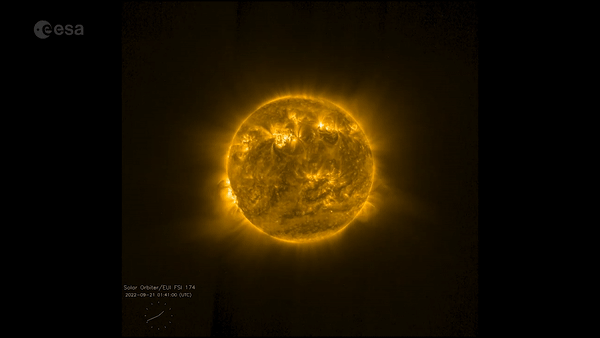The sun crackles in new images from spacecraft preparing for a close flyby
The sequence shows the sun in high-res over a 20-day period.

The Europe-led Solar Orbiter mission has captured a stunning sequence of the lively star at the center of our solar system as it made its closest approach amid intensifying solar activity.
The European Space Agency (ESA), which operates the spacecraft, released the sequence on the day of the spacecraft's closest approach, or perihelion, on Wednesday (Oct. 12). The images show 20 days of Solar Orbiter's observations of the star, taken between Sept. 20 and Monday (Oct. 10).
The images were taken with the spacecraft's high-resolution Extreme Ultraviolet Imager (EUI) operating in the full sun mode that enables scientists to view the entire star. The video reveals the rotating star sparkling with activity in its gaseous atmosphere, the corona, which reaches temperatures of up to 1.8 million degrees Fahrenheit (1 million degrees Celsius).
Scientists enhanced the colors in the sequence because human eyes cannot see the ultraviolet wavelength detected by the instrument, ESA said in a statement.
Related: The sun as you've never seen it: European probe snaps closest-ever photo of our star
Solar Orbiter makes regular close passes of the sun at about one-third of the sun-Earth distance, within the orbit of the planet Mercury. On this flyby, the spacecraft's fifth, it reached the closest point to the sun today at 3:12 p.m. EDT (1912 GMT).
Solar Orbiter, launched in 2020, doesn't make as close dives toward the star as NASA's Parker Solar Probe, but unlike Parker carries high-resolution cameras that wouldn't survive in the extremely hot environment that Parker visits. Together, the two probes are enabling giant leaps in our understanding of the star at the center of our solar system.
Get the Space.com Newsletter
Breaking space news, the latest updates on rocket launches, skywatching events and more!
Solar Orbiter also makes regular flybys of the planet Venus, using its gravity to gradually tilt its orbit out of the ecliptic plane in which planets orbit. These maneuvers will eventually allow Solar Orbiter to view the sun's poles in detail, which no spacecraft has done before. Scientists believe that the polar regions harbor clues about how the star generates its magnetic field, which in turn drives its 11-year cycle of activity, the ebb and flow in the production of sunspots, solar flares and eruptions.
Solar activity has been picking up over the past year, causing all sorts of problems in the near-Earth environment. Satellite operators have reported struggles with maintaining spacecraft orbits near the planet because the interaction of the solar wind, the stream of charged particles emanating from the sun, with Earth's atmosphere increased the drag experienced by the satellites. In February, SpaceX lost an entire batch of its Starlink internet satellites after launching into a mild geomagnetic storm caused by a solar eruption. A major solar flare disrupted radio communications in North America just as the U.S. was recovering from the rampage of Hurricane Ian.
Missions such as Solar Orbiter and the Parker Solar Probe will help scientists better understand the behavior of the star and predict its tantrums so that we can better protect technology on Earth and in space in the future.
Follow Tereza Pultarova on Twitter @TerezaPultarova. Follow us on Twitter @Spacedotcom and on Facebook.
Join our Space Forums to keep talking space on the latest missions, night sky and more! And if you have a news tip, correction or comment, let us know at: community@space.com.

Tereza is a London-based science and technology journalist, aspiring fiction writer and amateur gymnast. Originally from Prague, the Czech Republic, she spent the first seven years of her career working as a reporter, script-writer and presenter for various TV programmes of the Czech Public Service Television. She later took a career break to pursue further education and added a Master's in Science from the International Space University, France, to her Bachelor's in Journalism and Master's in Cultural Anthropology from Prague's Charles University. She worked as a reporter at the Engineering and Technology magazine, freelanced for a range of publications including Live Science, Space.com, Professional Engineering, Via Satellite and Space News and served as a maternity cover science editor at the European Space Agency.









